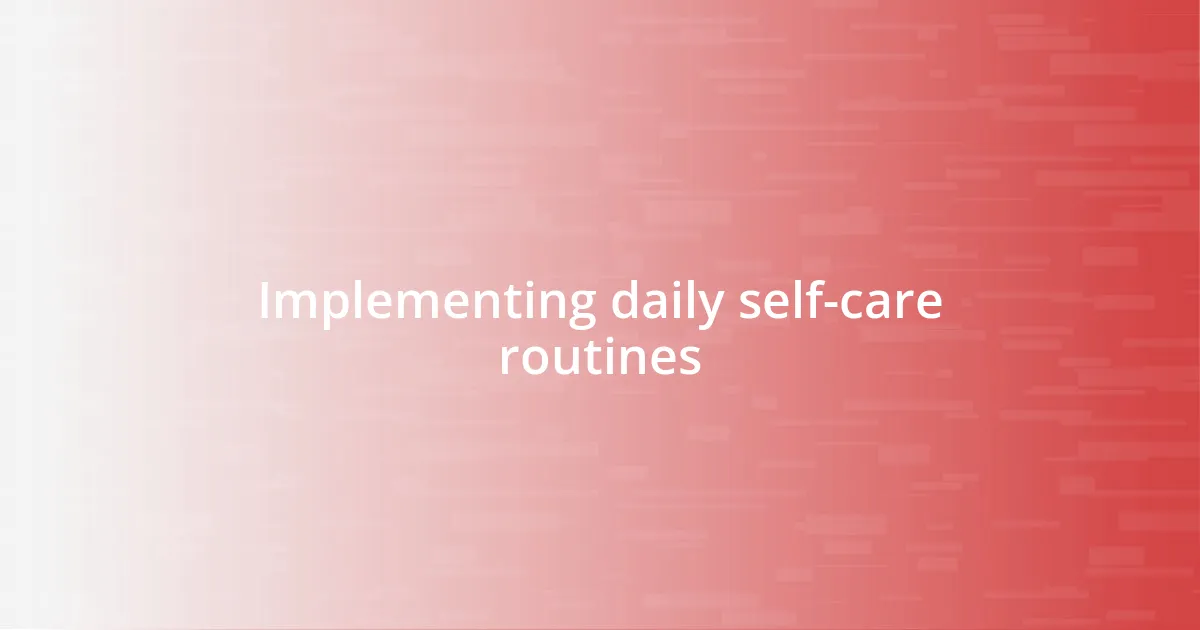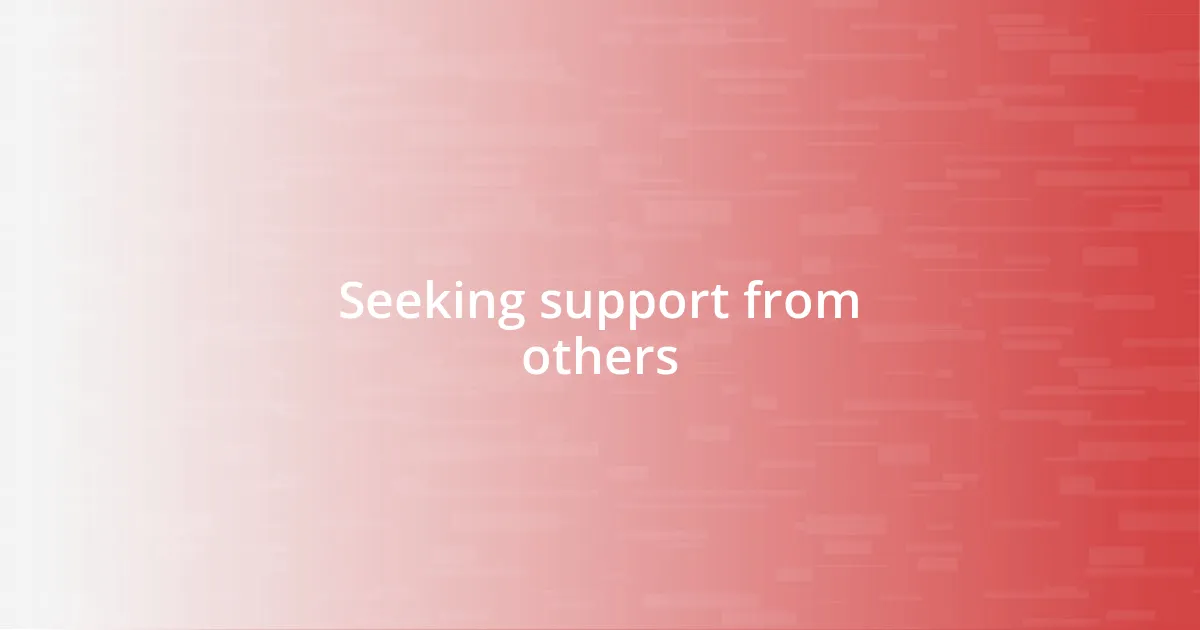Key takeaways:
- Burnout is often caused by prolonged stress, lack of control, and isolation, leading to chronic fatigue, emotional volatility, and loss of motivation.
- Effective coping strategies include setting boundaries, engaging in physical activity, practicing mindfulness, and maintaining social connections.
- Daily self-care routines, such as gratitude practices and physical movement, significantly enhance mental well-being and resilience against burnout.
- Reflecting on progress and making necessary adjustments can empower individuals to set healthy boundaries and improve emotional responses.

Understanding burnout causes
Burnout often creeps in quietly, usually stemming from prolonged stress at work or in daily life. I remember a time when I juggled multiple projects, thinking I was just being productive. But it wasn’t long before I felt mentally and emotionally drained, questioning whether my efforts were truly worth it.
One significant cause of burnout can be a lack of control in one’s life or job. I’ve felt that frustration myself, where responsibilities piled up, and I had little say in prioritizing tasks. How often do we find ourselves at the mercy of our schedules, feeling as though we’re merely reacting rather than actively participating in our lives?
Moreover, let’s not forget the impact of isolation. During a particularly overwhelming period, I noticed I was withdrawing from friends and family, thinking I needed to tackle my workload alone. But instead, that isolation amplified my feelings of burnout. Isn’t it ironic that, in seeking to avoid burdens, we sometimes create more distance from the very support we need?

Recognizing personal burnout signs
Recognizing burnout can be quite tricky, especially when you’re in the thick of it. I once dismissed the constant fatigue I felt as just being busy, only to realize later that my body was sending me signals that I ignored. Chronic exhaustion, whether physical or mental, doesn’t simply fade away; it’s a clear sign that your mental reserves might be running on empty.
Another indicator I noticed was a shift in my emotions. I found myself getting easily irritated over small inconveniences that wouldn’t have bothered me before. This emotional volatility is often a sign of being overwhelmed. Do you feel similarly? If you catch yourself snapping at loved ones or feeling perpetually on edge, it might be time to reflect on your current state.
Finally, the quality of my work began to suffer. Tasks that once excited me felt tedious and uninspiring. I remember staring at the screen, struggling to find motivation. This loss of enthusiasm is a classic marker of burnout, often overlooked. Taking a moment to evaluate how you’re feeling about your daily tasks can bring clarity to your situation.
| Burnout Signs | Personal Experience |
|---|---|
| Chronic Fatigue | Ignored exhaustion, thinking it was just a busy phase. |
| Emotional Volatility | Felt irritability over minor issues, which was unusual for me. |
| Loss of Motivation | Struggled with enthusiasm for tasks I once enjoyed. |

Effective coping strategies for burnout
Finding effective coping strategies for burnout is crucial, and I’ve had some firsthand experience that shines a light on what truly helps. One of the strategies that made a difference for me was setting clear boundaries. I recall a time when I allowed work to seep into my personal life far too often—late-night emails became the norm. Once I began turning off notifications and designating specific work hours, I felt a sense of liberation. It was as if a weight was lifted, allowing me to reclaim the time I so desperately needed for myself.
Here is a list of additional coping strategies that you could consider:
- Mindfulness and Meditation: Taking just a few moments each day to breathe deeply and center myself helped alleviate stress.
- Physical Activity: I found that moving my body, whether through a brisk walk or yoga, provided an instant mood boost.
- Connect with Others: Instead of isolating myself, I reached out to a friend for a chat or coffee, feeling immensely supported afterward.
- Prioritize Sleep: Establishing a regular sleep routine helped restore my energy levels significantly.
- Engage in Hobbies: Diving into activities I love, like painting or reading, offered a joyful escape from my daily responsibilities.
Most importantly, learning to ask for help when needed has transformed my approach to stress. In doing so, I realized that vulnerability isn’t weakness; rather, it’s a stepping stone to finding the support I need. The push to manage everything alone only heightened my burnout. By leaning on others, I created a network of support that not only bolstered my mental health but reminded me that I’m not alone on this journey.

Implementing daily self-care routines
Daily self-care routines became my lifeline when I recognized how essential they are for my mental well-being. For instance, I developed a habit of starting each day with a few moments of gratitude, jotting down three things that brought me joy. This simple practice shifted my mindset and set a positive tone for the day ahead. Have you ever tried something so small that had a big impact? I found it profoundly uplifting.
Incorporating physical movement into my routine also played a significant role in fighting burnout. I remember feeling lethargic and unmotivated, so I committed to a daily 20-minute walk. This not only invigorated my body, but it also cleared my mind, allowing for creativity to seep back in. How often do we overlook our physical health when we’re overwhelmed? I learned that even a small investment in self-care can yield great returns.
Additionally, I discovered the power of evening rituals. After a long day, I would carve out time to unwind with a personal favorite—cooking. The act of chopping vegetables and stirring a pot felt meditative, pulling me away from the stresses of the day. What activities help you find peace after a busy day? For me, that cooking ritual became a soft reset, allowing me to transition into a restful night.

Seeking support from others
Often, I found the greatest relief from burnout when I opened up to friends and family. There was a time when I felt utterly alone in my struggles, believing I had to handle everything on my own. However, one night over dinner, I decided to share my feelings. Their understanding and encouragement not only provided a much-needed weight off my shoulders but also sparked conversations that offered new perspectives on my situation. Have you ever noticed how a simple chat can shift your entire mindset?
Connecting with others also meant seeking support groups, either online or in person. When I joined a local wellness circle, I realized that many people were grappling with similar challenges. It was eye-opening to listen to their stories, and I felt a sense of camaraderie that I hadn’t anticipated. Being able to share both my victories and struggles in that safe space allowed me to gain insights and tips that I’d never considered before. Isn’t it incredible how community can empower us during tough times?
Moreover, professional help became a vital part of my healing journey. I reached out to a therapist who specialized in burnout, and our sessions were transformative. Listening to her professional guidance helped me identify deeply rooted issues and effective coping strategies I had been overlooking. Have you thought about the benefits of talking to someone who can provide objectivity? For me, that external perspective was invaluable, paving the way for greater clarity and hope in my journey toward recovery.

Long-term prevention of burnout
To truly prevent burnout in the long run, I learned the importance of creating boundaries around my work. There was a time when I felt guilty shutting my laptop at a decent hour, convinced that staying longer equated to being more productive. But I found that honoring my own time, stepping away for breaks, and eventually logging off after work hours cultivated a healthier balance. Have you ever realized how much time you actually have when you allow yourself to disconnect?
Establishing a sustainable workload was another game-changer for me. I recall moments of saying “yes” to every project, blurring the lines between personal life and work. Eventually, I began to assess my capacities honestly—prioritizing what truly aligned with my long-term goals. I started looking at my calendar and blocking out time just for me. Could creating time for short pauses amidst your tasks enhance your focus and energy? For me, it made all the difference in maintaining enthusiasm and avoiding that dreaded fatigue.
Lastly, I embraced the art of mindfulness, which has woven its way into my daily fabric. I remember my first attempt at meditation was riddled with impatience, but gradually, I found solace in simply being with my thoughts. This practice taught me to remain present, especially during stressful times. Do you ever find yourself racing through deadlines, missing opportunities to breathe? Diving into mindfulness transformed my perspective, reminding me that slowing down can indeed lead to greater clarity and productivity.

Reflecting on progress and adjustments
Reflecting on my journey through burnout has been as enlightening as it has been challenging. When I took a step back to assess how far I had come, I realized just how significant small victories can be. I recall a particularly tough week when I managed to hold my boundaries and not overcommit myself. It felt exhilarating to say “no” to a request that once would’ve had me stretching myself thin. Have you ever felt that rush of empowerment from choosing what’s best for you?
Adjustments became necessary as I navigated this path towards recovery. I learned that some habits needed re-evaluation. One day, after a particularly stressful day at work, I took a moment to jot down what was weighing on my mind. I was shocked to see that simple task management had transformed into an exhausting cycle. Realizing I was inadvertently sabotaging my peace was a wake-up call. Have you ever unearthed a surprising realization about your routines that made you rethink everything?
As I reflected more, I became attuned to my emotional responses throughout the day. I noticed patterns of fatigue following unproductive meetings. So, I started actively scheduling short breaks, allowing myself to reset mentally. This little shift allowed me to return with fresh insights and improved focus. Isn’t it fascinating how a simple adjustment can lead to monumental changes in your overall well-being? These reflections guided me in fine-tuning not only my workload but also my emotional responses, making my journey much more manageable.















